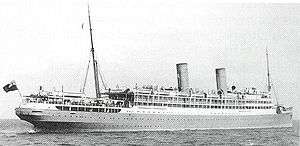Canadian Northern Railway
The Canadian Northern Railway[1] (CNoR) was a historic Canadian transcontinental railway. At its 1923 merger into the Canadian National Railway (reporting mark CN), the CNoR owned a main line between Quebec City and Vancouver via Ottawa, Winnipeg, and Edmonton.
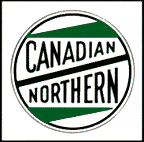 | |
| Overview | |
|---|---|
| Headquarters | Toronto, Ontario |
| Locale | Canada |
| Dates of operation | 1899–1923 |
| Successor | Canadian National Railway |
| Technical | |
| Track gauge | 4 ft 8 1⁄2 in (1,435 mm) standard gauge |
Manitoba beginnings
The network had its start in the independent branchlines that were being constructed in Manitoba in the 1880s and 1890s as a response to the monopoly exercised by Canadian Pacific Railway (CPR). Many such lines were built with the sponsorship of the provincial government, which sought to subsidize local competition to the federally subsidized CPR; however, significant competition was also provided by the encroaching Northern Pacific Railway (NPR) from the south.
Two branchline contractors, Sir William Mackenzie and Sir Donald Mann, took control of the bankrupt Lake Manitoba Railway and Canal Company in January, 1896. The partners expanded their enterprise, in 1897, by building further north into Manitoba's Interlake district as well as east and west of Winnipeg. They also began building and buying lines south to connect with the U.S. border at Pembina, North Dakota, and east to Ontario.
Connecting the Prairies to the Lakehead
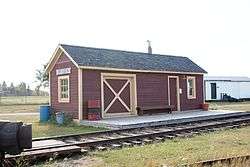
The Canadian Northern Railway was established, in 1899, and all railway companies owned by Mackenzie and Mann (primarily in Manitoba) were consolidated into the new entity. CNoR's first step toward competing directly with CPR came at the start of the 20th century with the decision to build a line linking the Prairie Provinces with Lake Superior at the harbour in Port Arthur-Fort William (modern Thunder Bay, Ontario), which would permit the shipping of western grain to European markets as well as the transport of eastern Canadian goods to the West. This line incorporated an existing CNoR line to Lake of the Woods and two local Ontario railways, the Port Arthur, Duluth and Western Railway and the Ontario and Rainy River Railway, whose charters Mackenzie and Mann had acquired in 1897.
To reach Port Arthur, which became the lake terminus of the CNoR, the line extended south of Lake of the Woods into northern Minnesota before heading northeast through Rainy River District to the head of navigation on the Great Lakes. The Winnipeg-Port Arthur line was completed on December 30, 1901, with the last spike being driven just east of Atikokan station by Ontario's Commissioner of Crown Lands, Elihu Davis.
Meanwhile, Mackenzie and Mann expanded their prairie branch line operations to feed the connection to Port Arthur. From a series of disconnected railways and charters, the network became 1,200 miles of profitable and continuous track that covered most of the prairies by 1902.[2]
Northern expansion
After receiving grants from the Province of Manitoba and the Dominion of Canada in the 1890s, Mackenzie and Mann began building lines further north in Manitoba, with the intention of eventually reaching Hudson Bay. Throughout the 1890s, they reached Swan River, and continued building north between the Porcupine Hills to the west and Lake Winnipegosis to the east.
In 1900, Mackenzie and Mann directed this northern line west into the Northwest Territories (later Saskatchewan), where it eventually terminated at E.R. Wood (later Erwood). This northwestern line mainly carried lumber and was extended to Melfort between 1903 and 1905.
In 1907, the Canadian Parliament pressured Mackenzie and Mann to continue building more rail towards Hudson Bay. In that year, they created a junction on the Erwood to Melfort line near the mouth of the Etoimami river, where Fort Red Deer River existed, and a line was extended north to The Pas. By 1910, the settlement at this junction was renamed Hudson Bay Junction, and the line was completed between the junction and The Pas.
The long section of rail between The Pas and Churchill was never completed by CNoR. However, after CNoR was acquired by CN, the line was completed in 1929.[3] (see Hudson Bay Railway)
Transcontinental
Once elected in 1896, Prime Minister Wilfrid Laurier was eager for a second transcontinental.[4] However, an expansion of the non-CPR railways west of Alberta would be a mammoth questionable gamble for the operators.[5] Adding an equally costly route to supplement the existing uneconomical CP track through Ontario seemed more ludicrous.[6] At the time, the CNoR planned to advance no further west than Edmonton.[7] In 1902, the GTR held talks with Laurier and agreed to build a transcontinental under the auspices of the GTPR for the western portion, with the eastern portion built by the government-owned NTR.[8] The CNoR, which had a charter to build westward to the mouth of the Skeena River[9] was alarmed, but in no hurry, because it believed the GTPR would choose one of the more northerly passes to cross the Canadian Rockies, leaving the Yellowhead Pass for the CNoR.[10] Despite promptings, the GTP was unwilling to collaborate with the CNoR in any joint construction.[11]
Western Canada expansion
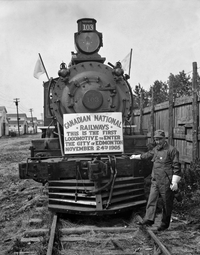
In 1905, CNoR reached Edmonton,[12] which had just been named capital of the newly formed province of Alberta. Rather than competing with the GTPR in having a terminal at the mouth of the Skeena, the CNoR accepted the BC government subsidies to switch to the Vancouver area. When the GTPR selected the Yellowhead route, the CNoR protests created only some delays.[10] In 1911, work was started on a new townsite named Port Mann on the Fraser River that would accommodate the new car shops, and from where lines would extend to Vancouver and the Fraser River delta.
CNoR's initial expansion in the 1890s and 1900s had been relatively frugal, largely by acquiring bankrupt companies or finishing failed construction projects.[7] By the 1910s, significant expenses were accumulating. The CNoR started construction west of Edmonton in 1910, fully two years later than GTPR. The construction through the Rockies, which was expensive, largely paralleled the GTPR line of 1911, creating about 100 miles of duplication.[13] However, the largest costs were from building on "the wrong side" of the Thompson and Fraser rivers in the Coast Mountains of British Columbia. CPR already had trackage on the desirable banks, forcing the CNoR to blast tunnels and ledges out of these canyons.
The most infamous construction folly on the CNoR in British Columbia happened in 1913, when blasting for a passage for the railway at Hells Gate triggered an enormous landslide which partially blocked the narrow swift-flowing Fraser River. The resulting damage to Pacific salmon runs took decades to reverse by the governmental construction of fishways.
Eastern Canada expansion
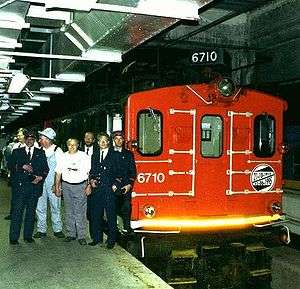
Mackenzie and Mann began their first significant expansion outside of the prairies with the purchase of Great Lakes steamships, the fr:Quebec and Lake St-John Railway (1906) into northern Quebec's Saguenay region and the acquisition of branchlines in southwestern Nova Scotia (the Halifax and Southwestern Railway) and western Cape Breton Island. Other acquisitions were in southern Ontario and a connecting line was built from Toronto to Parry Sound.
In 1908, a line was built east from a connection at Capreol, Ontario, on the Toronto – Parry Sound line to Ottawa and on to Montreal. In 1910 a direct Toronto–Montreal line was built. In 1911, federal funding enabled construction of the line Montreal – Ottawa – Capreol – Port Arthur. In 1912, with GTR and CPR holding the ideal southern routes around Mount Royal to downtown Montreal, CNoR started building a double-tracked mainline north by excavating the Mount Royal Tunnel.
Steamships
In 1910 the company entered the trans-Atlantic liner business with the founding of the Canadian Northern Steamship Company. The subsidiary acquired two liners from the Egyptian Mail Steamship Company and operated them under its Royal Line brand. The pair of ships were renamed upon purchase—Cairo became Royal Edward and Heliopolis became Royal George—and refitted for travel on the North Atlantic. In Royal Line service, Royal Edward sailed from Avonmouth to Montreal in the summer months and to Halifax in the winter months. At the outbreak of the World War I, Royal Edward and Royal George were both requisitioned for use as troopships.
On August 13, 1915, the German submarine UB-14 sank Royal Edward, which was transporting troops from Avonmouth to Gallipoli.
Royal George was sold to Cunard in 1916, became an emigrant ship in Cherbourg by 1920 and scrapped in 1922 in Wilhelmshaven.[14]
Plans for a trans-Pacific service were mothballed.[15]
Resort development
In 1914, to develop a resort on Grand Beach, CNoR bought a 150-acre (0.61 km2) homestead north of Winnipeg on the shores of Lake Winnipeg,
Financial trouble and nationalization
By 1914, with the company's financial predicament threatening the solvency of its major financier, the Bank of Commerce,[16] the CNoR appealed for government help.[17] The last spike of the CNoR transcontinental railway was driven January 23, 1915, at Basque, British Columbia,[18] with Montreal-Vancouver freight and passenger services commencing six months later,[19] and providing a rail network in Nova Scotia, Southern Ontario, Minnesota, and on Vancouver Island. Between 1915 and 1918, CNoR tried desperately to increase profits, but CPR garnered the majority of wartime traffic. The company was also saddled with ongoing construction costs associated with the Mount Royal Tunnel project.
CNoR was heavily indebted to banks and governments, and its profitable branchlines in the prairie provinces — "Canada's breadbasket" — would not generate enough revenue to cover construction costs in other areas. Unable to meet its debts, the company became desperate for financial aid. In 1917, the federal government effectively took control of the company.[20] As a condition for further funding, the government became the majority shareholder. On September 6, 1918, the directors, Mackenzie and Mann, resigned, replaced by a government-appointed board. Subsequently, CNoR executive David Blyth Hanna, and his team, managed not only CNoR operations, but also the federally owned Canadian Government Railways (CGR). On December 20, 1918, a Privy Council order directed CNoR and CGR to be managed under the moniker Canadian National Railway (CNR) as a means to simplify funding and operations, but CNoR and CGR would not formally merge and cease corporate existence until January 20, 1923, the date parliament passed the final act to incorporate CNR.[21]
Significant portions of the old CNoR system survive under CN (as the CNR has been known since 1960); for example:
- the Mount Royal Tunnel and suburban line to Deux-Montagnes, Quebec
- the line from Montreal (Pointe-aux-Trembles) northeast to Saguenay, Quebec
- the CN main line north and west from Toronto to Longlac, Ontario, about 900 km east of Winnipeg
- the CN main line from the Yellowhead Pass southwest to Vancouver.
The majority of CN's former CNoR branchline network across Canada has either been abandoned or sold to shortline operators. An important U.S. subsidiary of CNoR, the Duluth, Winnipeg and Pacific Railway, forms part of a key CN connection between Chicago and Winnipeg.
Footnotes
- Railway Equipment and Publication Company (June 1917). The Official Railway Equipment Register. p. 356 – via Google Books.
- MacKay 1986, pp. 56 & 57.
- Hudson Bay & District Cultural Society (1982). Valley Echoes: Life Along the Red Deer River Basin. Winnipeg, Manitoba: Inter-Collegiate Press.
- MacKay 1986, pp. 60 & 61.
- MacKay 1986, pp. 59, 63, 64, & 66-68.
- MacKay 1986, p. 67.
- MacKay 1986, p. 57.
- MacKay 1986, pp. 63 & 66.
- MacKay 1986, p. 62.
- MacKay 1986, p. 80.
- MacKay 1986, p. 64.
- MacKay 1986, p. 70.
- "Map of duplicate track lifted 1917" (PDF). www.railwaystationlists.co.uk.
- "Royal George, Cunard Line". Norway Heritage. Retrieved July 6, 2013.
- MacKay 1986, p. 105.
- MacKay 1986, p. 119.
- "Fort George Tribune, 28 Mar 1914". www.pgnewspapers.pgpl.ca.
- MacKay 1986, p. 104.
- "Fort George Herald, 26 Feb 1915". www.pgnewspapers.pgpl.ca.
- "Prince George Star, 22 May 1917". www.pgnewspapers.pgpl.ca.
- MacKay 1986, p. 121.
References
| Wikimedia Commons has media related to Canadian Northern Railway. |
- "1913 CNoR Map". www.paullantz.com.
- MacKay, Donald (1986). The Asian Dream: The Pacific Rim and Canada's National Railway. Douglas & McIntyre. ISBN 0-88894-501-9.CS1 maint: ref=harv (link)
- "Canadian Rail, May-Jun 1961" (PDF). www.exporail.org. Canadian Railroad Historical Assn. pp. 58–63.
- "Canadian Northern Railway in Port Hope". wwwporthopehistory.com.
See also
- Bay of Quinte Railway (acquired 1910)
- Canadian Northern Pacific Railway (subsidiary, incorporated 1910)
- Central Ontario Railway (acquired 1911 as part of Irondale, Bancroft & Ottawa Railway)
- Halifax and Southwestern Railway (acquired post-1906)
- Railway Museum of Eastern Ontario (former CNoR Smiths Falls station)
- Qu'Appelle, Long Lake and Saskatchewan Railroad and Steamboat Company (acquired July 1906)
